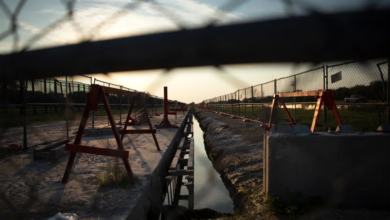
OP-ED: The Fed’s latest housing bubble
Is the current housing market in a bubble that is ready to pop? If so, what is the source and magnitude of the market distortion? The topic of a possible housing bubble has been a topic of discussion lately, especially before Fed officials went on the warpath against Consumer Price Index (CPI) inflation. I have been asked about this issue and below is a truncated response to all those inquiries.
I was asked in 2005 to write a chapter about housing bubbles for a proposed book on housing economics and government intervention.
Much of the book would be about matters like government planning, zoning, eminent domain, and various government subsidies. My chapter would be a “macro” topic in contrast to the many “micro” housing topics.
I had been following and writing about the then current housing bubble (HB1) since 2003, having just left a stint in the Alabama Banking Department as the Assistant Superintendent of Banking in Alabama to take a professorship of macroeconomics at Columbus State University in Georgia.
I wrote for LewRockwell.com and mises.org about the housing bubble and in 2005 I published my article “Skyscrapers and Business Cycles” in the Quarterly Journal of Austrian Economics which made the general theoretical connection between Fed policy and real estate investments and in this case, the connection between Fed policy, record setting skyscrapers, and economic chaos.
While my chapter was submitted in 2006 it was not published in the intended book until 2009 during the aftermath of the bubble.1
Not only did the editors invite me to include material in the final published version that they had originally deleted as too controversial. They also drew attention to my chapter at the beginning of their introduction to the book:

.
To the extent that the media was aware of my work, especially on the skyscraper curse, the response and level of appreciation was mixed. On the one hand, CNN was positive, if not surprised, that my work was so accurate and specific:
![]()
One person who wasn’t surprised by the economic woes greeting the dedication of the Burj Khalifa (renamed Monday from Burj Dubai in honor of the sheikh of Abu Dhabi, which recently threw Dubai a $10 billion lifeline) was Auburn University economist Mark Thornton.
.
He predicted tough times for the emirate two years ago in a blog post entitled “New Record Skyscraper (and Depression?) in the Making.” He noted that economic depression or stock market collapse usually occurs prior to completion of such skyscrapers.
On the other hand, The Economist took my “skyscraper curse” model to task because it did not stand up to somebody else’s poor understanding of the data involved. The magazine did not actually use my name in their article, although my academic article is listed in their reference list although my name was missing there too.
My letter to their editor was not published and after many months I was extremely surprised to receive an email from them saying that my letter to the editor had been misplaced. Despite its discovery, they did not publish it. Extremely odd?
Review of the Charts
Here I will review the charts that I used in my 2006/09 chapter and update the charts for the current housing bubble. As you will see, the Fed clearly did not learn its lesson and stuck its fingers back into the cookie jar.
Of course, much more could be said about this housing bubble, but I will mention here that the bubble in real estate is cloaked in what my friend Kevin Duffy correctly calls the “everything bubble.”2
The first chart is based on the federal funds rate, which is the Fed’s main policy interest rate. They can control it directly and because it is the interest rate that banks charge other banks for very short-term loans, it sets the foundation for most other interest rates in the economy.
.
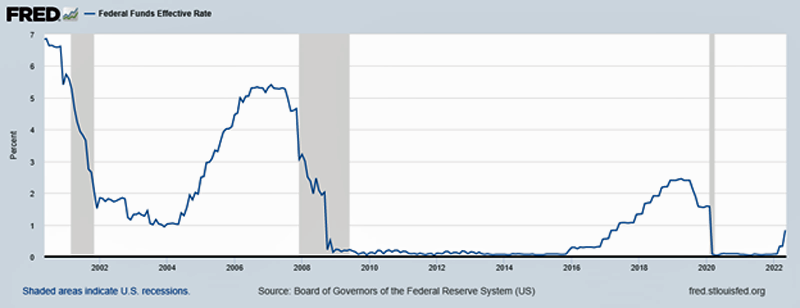
My chapter was completed in early 2006, but I had been studying and writing about the first housing bubble since early 2004. The paper was not published until 2009, long after the bubble burst and policy makers at the Fed and elsewhere were busily trying to cover up their mistakes.
At the far left of the graph, you can see the Fed has once again embarked on a normalcy/tightening phase that has only just begun.
The Fed has yet to raise its target rate above 1 percent. Balanced sheet reductions will be small until after the November election. Their response is particularly anemic so far given that CPI inflation is above 8 percent.
.
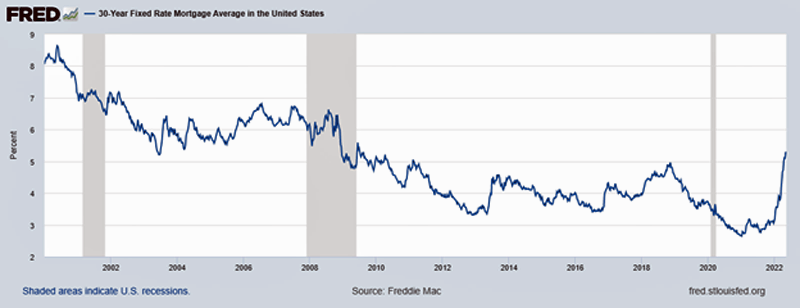
.
The thirty-year fixed-rate mortgage is a primary driver of housing bubbles. The 6 percent rate that caused the previous housing bubble seems high compared to recent years, but 6 percent is lower than at any time since we went off the gold standard in 1971.
The truly remarkable rates occurred only in the last few years when a combination of the Fed driving its policy rate to zero, massive quantitative easing, including massive purchases of mortgage-backed securities (MBS), and a tame CPI inflation led to the lowest rates ever, often less than 3 percent!
The Fed’s verbal war on CPI inflation by its top policy makers threatening large and sustained rate hikes and enormous balance sheet reductions, combined with out-of-control CPI inflation has moved market mortgage rates up sharply, now above 5 percent.
The shift in recent years to fixed rate mortgages and away from variable rate mortgages should insulate current holders but could also crush potential home buyers and eventually hurt mortgage investors, banks, the Federal Deposit Insurance Corporation (FDIC), and even the Fed itself, which is the largest investor in mortgages.
If CPI does not soon collapse, the Fed will have to move rates much higher and that would trigger a downturn in housing statistics including prices and new permits—the new housing bubble would go bust.
Recently on Bloomberg, a top Fed official was asked if its policy could reduce home prices and make it more affordable for first time buyers. The official quickly coughed and said the Fed would never reduce home prices, only the rate of increase. I’m glad that isn’t my job!
.
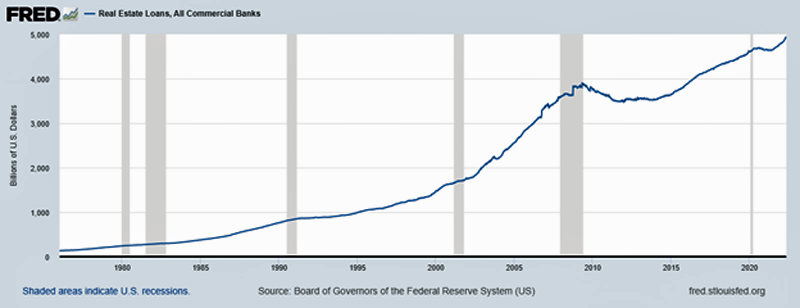
.
In the twenty years prior to completing my paper the total amount of real estate loans at commercial banks increased from $1 trillion to $3 trillion, a massive $2 trillion increase.
That same number increased from $3 to $5 trillion, another $2 trillion increase over the last fifteen years despite a soft or negative overall market from 2009 to 2015.
.
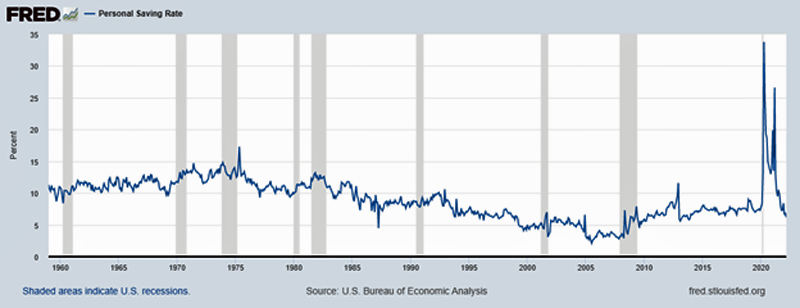
.
The personal saving rate was above 10 percent on the gold standard and few people were on the public dole. Since going off gold in 1971 the saving rate has been declining and registered near zero when I completed my chapter in 2006.
It has since risen to a higher level but remained below the gold standard percent-of-income level, until the covid-19 crisis hit, and the Fed went into its inflationary panic response in March 2020.
The Federal government also ran massive deficits combined with multiple rounds of “stimulus” vote buying sprees.
With vast amounts of free money and historic economic uncertainty, the personal saving rate spiked to over 25 percent and has since returned to the prior rate between five and 10 percent.
.
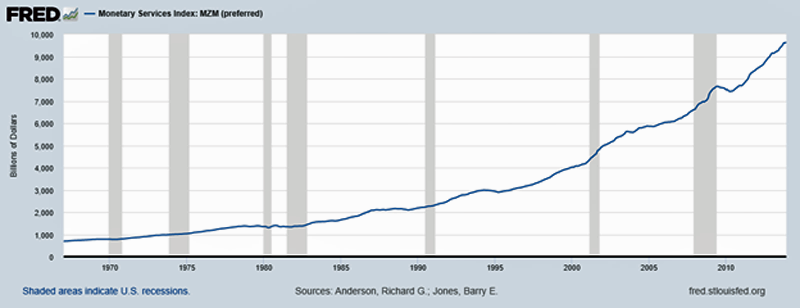
.
The money supply as measured by the MZM (money of zero maturity) statistics increased by 50 percent during the first housing bubble and has increased another 50 percent since then, increasing in the last few years from roughly $6 trillion to $9 trillion.
Obviously, the Fed is trying to do the impossible, which is to engineer and print the economy to prosperity, or whatever goal they are pursuing.
.
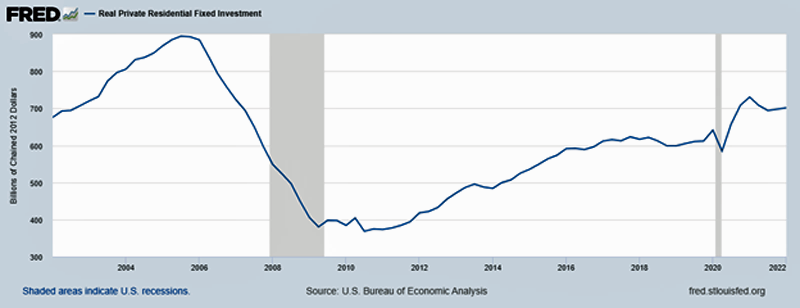
.
During the previous housing bubble, real private residential fixed investment increased substantially, nearly doubling in the fifteen years leading up to the bubble’s end.
During the second housing bubble, it has nearly doubled again. During the previous housing bubble, I marked the beginning of that bubble by noting that housing investment even increased during the prior recession.
Investment also spiked again in the recent short recession during 2020 which might suggest that the current bubble has yet to reach its final stages.
.
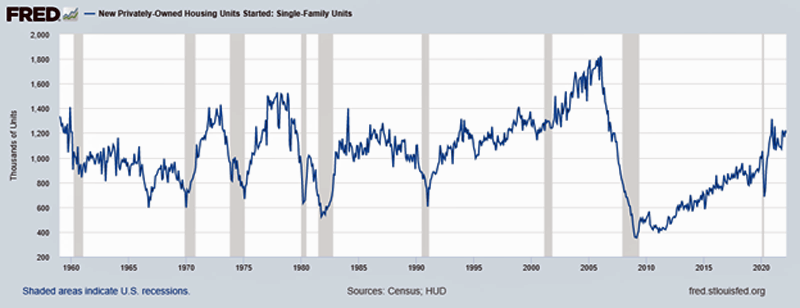
.
Another good measure of housing is the number of single unit housings starts, measured here with data on new privately owned housing units.
That number increased substantially in the fifteen years of the previous bubble, before dropping precipitously to a record low. Housing starts have been on a similar trajectory since the previous bubble-bust ended.
Although it has so far not reached the same height of the previous bubble its absolute increase is about the same and the number of multi-unit dwelling has noticeably surpassed the previous bubble.
Also, the number of employees in the construction industry has reached back to the previous record levels that occurred during the previous housing bubble.
.
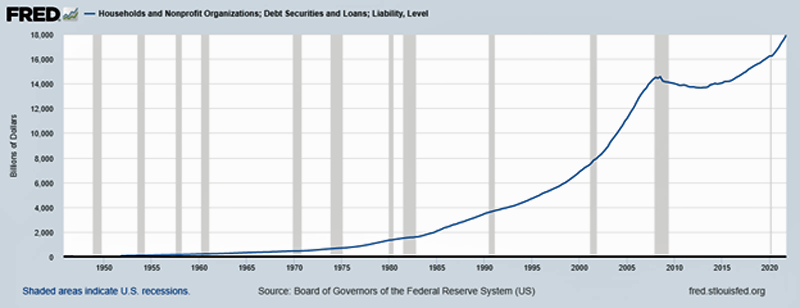
.
The amount of household debt increased enormously during the previous housing bubble and continued to increase for two years after my paper was completed, before hitting the crash/recession and tapering off for several years before being reignited and reaching its new highs.
Since mid-2013 household debt has increased by over 30 percent despite the covid-19 crisis bout of higher household savings.
There are a number of alternative explanations for the red-hot housing and construction sectors, but I have viewed this market as a bubble in the making for many years.
My anticipation is that while it could continue for some time, ultimately, we will see that mistakes were made caused by the Fed.
Prior to the last crash in housing prices, Fed officials told us there was no housing bubble, that the Fed had near-omniscience and power, and that they would intervene quickly to prevent a bubble or a bust in housing. They claim that was their own transparency, but it turns out it was really their deception of us.
Then on top of that, the Fed acquired new powers and authority, Congress enacted sweeping regulatory and reporting requirements, while everyone else became much more skeptical about house flipping, multiple home ownership, and the charms of “housing prices never go down,” and “no one ever lost money in real estate” maxims.
Now we hear that people are still desperate to buy a house despite outrageous prices. Those prices are bid up higher than asking prices.
That homes-for-sale inventories are non-existent in some markets and that available homes are snatched up instantly in other markets.
That buyers are in a catch-22 of rising prices and rising mortgage rates. That recent buyers can flip for a profit. To me, these are all echoes from a housing bubble being blown up to its inevitable breaking point.
- 1. Mark Thornton, “The Economics of Housing Bubbles,” in America’s Housing Crisis: A Case of Government Failure, ed. Benjamin Powell and Randall Holcombe (Oakland, CA: Independent Institute, 2009).
- 2. Bubbles usually get named after the sector most impacted by the Fed’s monetary inflation and low interest rate policy, but most asset classes have reached bubble proportions in this cycle. NOT SURE IF HE ACTUALLY COINED THE PHRASE.
Source: Mises Institute — Mark Thornton is a Senior Fellow at the Mises Institute and the book review editor of the Quarterly Journal of Austrian Economics. He has authored seven books and is a frequent guest on national radio shows.


